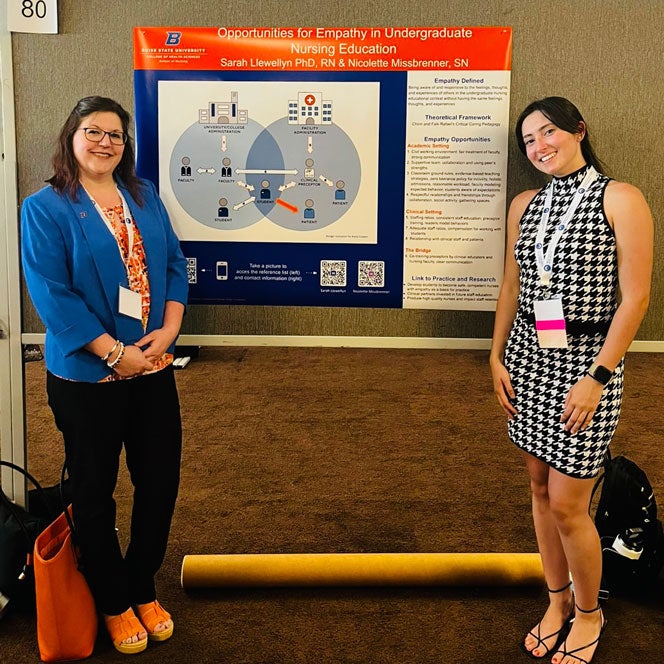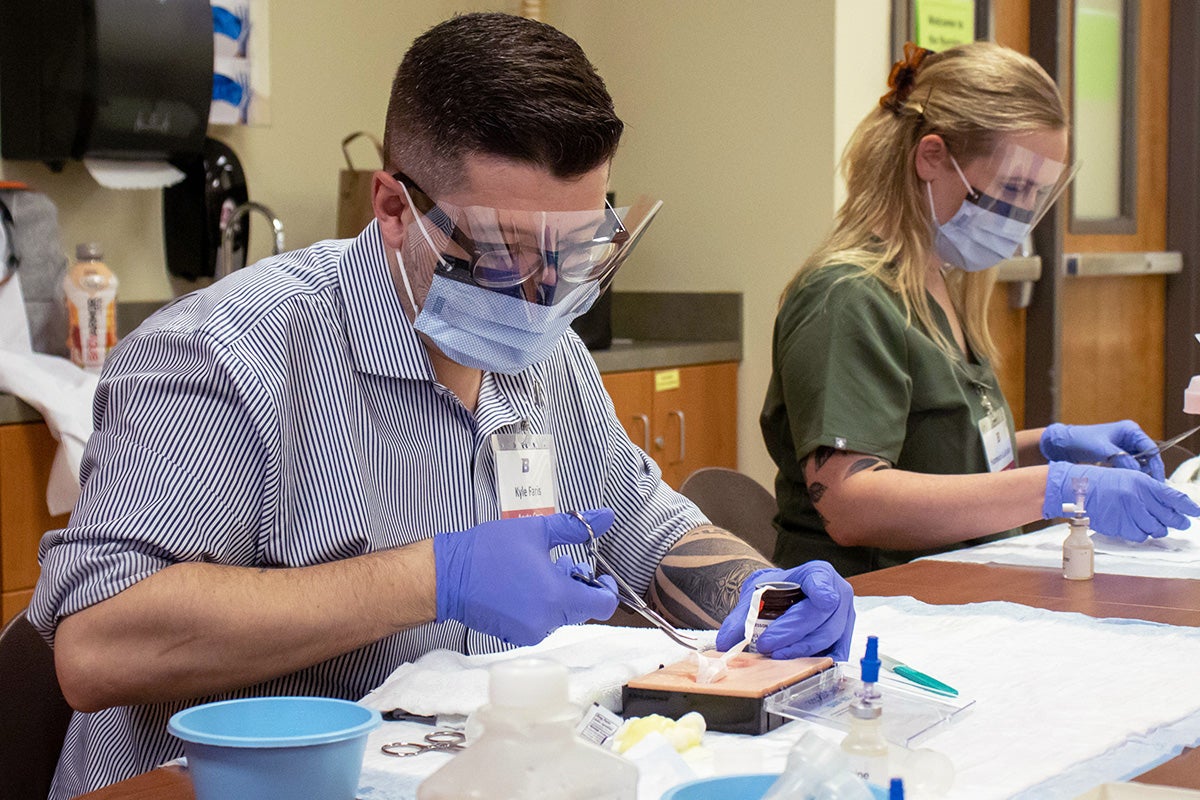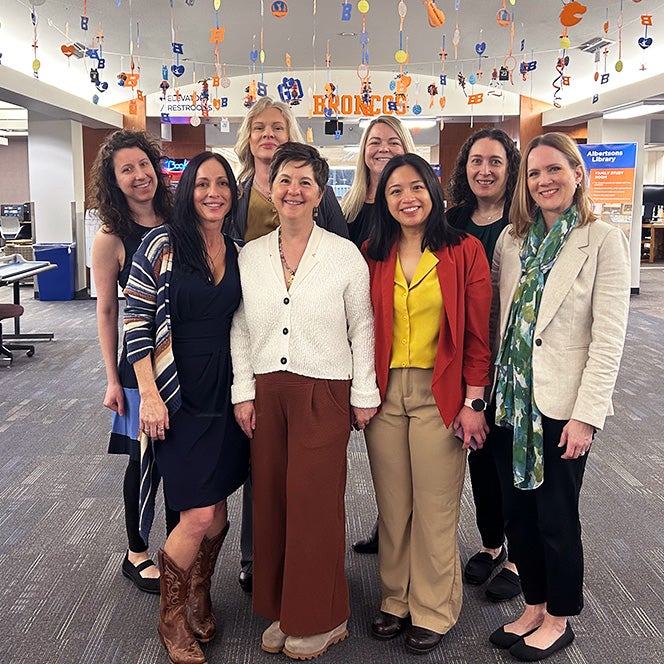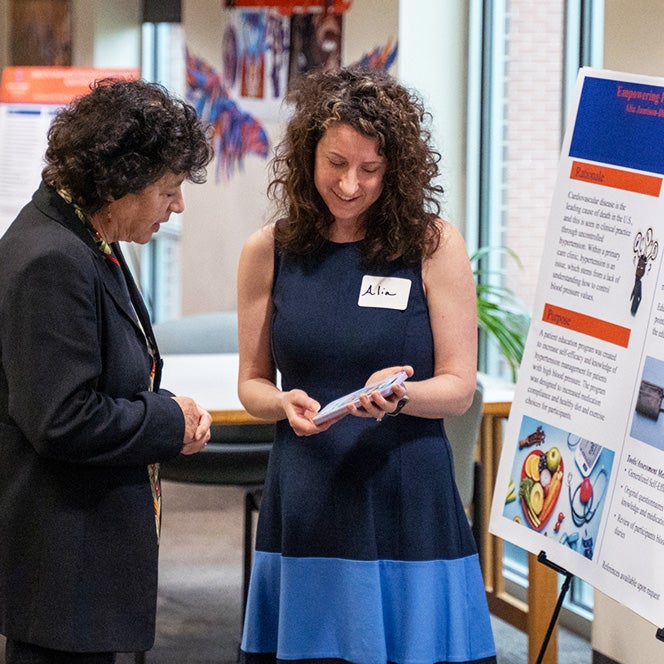Student to present evidence-based projects
Students from across the School of Nursing will present their evidence-based practice projects at the Treasure Valley Nursing Research Conference on May 15.
Five undergraduate students were invited to present. Another four projects – representing the work of 12 of Boise State’s nurse practitioner students – were also accepted to the conference.

“I’m so proud of the work these students accomplished, and am especially impressed that each student group was offered the opportunity to present,” said Clinical Associate Professor Jennifer Stock, the graduate students’ project advisor and an instructor in the Adult Gerontology Nurse Practitioner program.
“This confirms that our nurse practitioner students are committed to their education and evidence-based practice. Most importantly, it signifies our nurse practitioner students have the ability and dedication to improve patient outcomes.”
What is Evidence-Based Practice?
Healthcare today is based on years of science from the past. Over time, common practices evolve as new discoveries are made about the most effective methods of care.
Adapting clinical decisions based on evidence of positive patient outcomes is known as evidence-based practice, or EBP.
EBP research is one way to prioritize patient wellbeing. Instead of creating brand new studies to solve a healthcare problem, scholars evaluate and translate existing studies into actual practice.
Students in Boise State’s School of Nursing excel at this type of scholarship.
Nurse practitioner students dig into the evidence
Boise State’s nurse practitioner coursework requires students to work together in small groups on EBP projects. They bring real-world solutions to real time problems, investigating an issue that they’ve witnessed in their practice as registered nurses.
Noticing trends and digging deeper
Jessica Cruz, Jamie Hutt and Katie Tribley are all critical care nurses studying to become acute care nurse practitioners. For their EBP project, they looked at the benefit of using a specific anti-fibrinolytic medication (known as TXA) in response to bleeding in the brain.
The team had noticed a trend in healthcare providers ordering TXA for intracranial hemorrhage cases. But at the time they selected their topic, the protocols of Tribley’s current employer were to avoid giving TXA to patients with isolated head trauma.
“I thought it was intriguing,” Tribley said, wondering if the research around TXA and head trauma cases had changed. The group decided to find out.

TXA helps blood clot, so “it made sense to me that TXA would have a reduction on hemorrhage size when given to any patient with hemorrhage,” said Tribley. “Having said that, I was surprised the numbers were not as drastic as I had expected.”
Their research suggested that although none of the patients’ hemorrhages increased in size, they didn’t always have a significant decrease, either.
Tribley is grateful “for the opportunity to deep dive into evidence-based research” as part of her nurse practitioner education at Boise State. Over her decade in the field, she has noticed nursing practices “change drastically” because of EBP, from new medications to improved protocols and procedures.
“I find it fascinating to witness these changes and I am enthused to be a part of guiding the future of nursing as an advanced practice provider,” she said.
Evidence-based at every level of education
Evidence-based practice projects aren’t limited to nurse practitioner students or the pre-license program. Boise State students in the Online RN-BS Completion program and those earning their Doctor of Nursing Practice degree also rely on EBP.
Not just for graduate students
Alissa Godinez is a student in the Online RN-BS Completion program who worked as a licensed practical nurse while enrolled in classes. Thanks to the required research assignments in her program, she has a “better understanding” of EBP, she said.

“The National Library of Medicine is your best friend in this program,” Godinez said. “You have to cite everything under the sun, and the NLM and I have become best friends. But it’s really nice, because now I use that in my practice, even when patients ask me a question.”
Godinez recalls a time when she pointed a patient toward scholarly databases for answers instead of relying on general online search engines. She also taught them how to find relevant information within academic research articles.
Learning about EBP helped Godinez “understand the why” behind her work as a nurse. “For me, it’s been really nice to actually see ‘Okay, this is the actual research that was done for [practitioners] to get to this point,’” she said.
Scholarship for patient-centered care
Students in the Doctor of Nursing Practice program present their scholarly projects – which are also evidence-based – at the end of their program.

Similar to a dissertation, their EBP projects represent the culmination of their doctoral studies. This year, graduating students held a public poster presentation event in Albertsons Library and participated in the virtual graduate student showcase.
Two students, Nikki Graham and Rheza Agtarap, won the College of Health Sciences awards for their work, and Sara Weelborg received a Presidential Scholar Award. This honor distinguishes her for her project entitled, “Promoting Awareness and Knowledge of Nutrition as an Adjunctive Treatment Option for Chronic Insomnia.”

“The most rewarding parts of my scholarly project were forming and working with the multidisciplinary committee and observing the effects of its work,” Weelborg said. “The education module we produced was very well received, led to robust discussions, and directly impacted provider knowledge.”
Weelborg is an adult psychiatric nurse practitioner who implements EBP for patients with mental health challenges. By keeping up with recent research findings and practice guidelines, she’s been able to offer her patients more treatment options.
“Incorporating evidence-based practice into my work instills hopefulness in my patients that I have their best interest in mind and have partnered with them to navigate the complex world of psychiatric treatment,” she said.